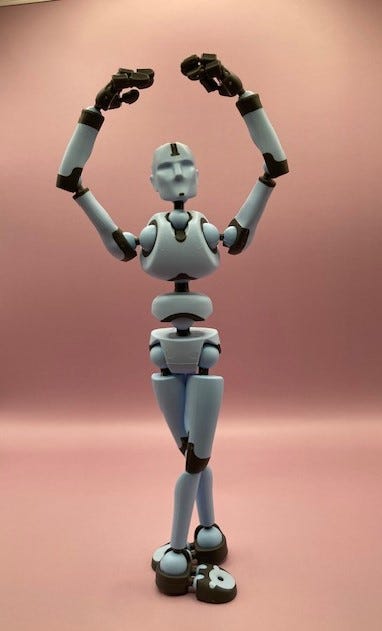French For Dancers Newsletter: Foot Positions, Part 2
French For Dancers
Demystifying dance terminology and steps for dancers and dance-lovers!
Issue 6: Foot Positions, Part 2
Bonjour! Welcome to French For Dancers!
Each newsletter, we will look at a dance term, its pronunciation, meaning, use. Often, different dance techniques will use varying terminology for the same step, so I will try to include those, too.
Continuing our exploration of the 5 Basic Foot Positions in Ballet! And we’ll throw in a little math lesson, too…
Parlez-Vous Ballet?
(Do you speak Ballet?)
Positions of the Feet
Last week, we looked at 1st, 2nd, and 3rd positions – and now we move on to 4th and 5th positions!
Fourth Position (Quatrième Position)
In Fourth position, the legs separate slightly in a forward/backward direction. There are two ways to do this, open (ouvert) or crossed (croisé).
For a more open fourth, start in first or third position and open the front foot about one to one and a half of your own foot’s length. The heel of the front foot should be directly in front of where it started, either the back heel (from 1st) or mid-foot (from 3rd).
For a more crossed fourth, start in fifth and open the front foot so that the front heel is still opposite the back big toe.
Either way, the body’s weight is distributed evenly between both feet, much as it is in second position, and both legs are turned out.
Fourth position is an open position, used as a preparatory position for some pirouettes (turns) and certain jumps.
Fifth Position (Cinquième Position)
Fifth position is similar to third position, but the feet cross over one another at a tighter angle, with the thighs also crossing one another. The heel of the front foot touches the big toe of the back foot – exactly where depends on the technique being taught.
In the Cecchetti (Italian) technique, the front heel touches the big toe joint of the back foot so that the big toe of the back foot can be seen from the front. This makes for a kinder, gentler version of fifth, great for students who are ready to move beyond third, but still working on their turnout. It places less stress on the ankle and knee joints while still allowing dancers to develop their turnout and build strength in the inner thigh and rotator muscles.
In the French and Russian schools of technique, fifth position is a fully crossed position, heel to toe, so that the back toes are not visible from the front. As turnout progresses, the feet may be able to position themselves flush to one another.
Bonus: Sixth Position (Sixième Position)
Some teachers use sixth position as a name for parallel first position, with both feet together, heels next to each other and toes pointed forward. This is a position often used at the barre for warm-ups, and an excellent position to use for foot and ankle stability and strength exercises. It is also a position used in modern and jazz.
Savoir-Faire
(Know-How)
Student Tip:
What’s with all the geometry in ballet? Math alert!
We talk about degrees a lot in dance – like 180-degree turnout, 45-degree lift in dégagé, 360-degree turn. Degrees are an indication of the size of an angle, which in dance translates to the size of an opening, or the amount of rotation a movement needs.
To help you remember, a circle is 360 degrees all the way around. So, a full turn would be 360. Two rotations would be 720 (360x2) – think Julie Andrews spinning on the mountaintop in The Sound of Music.
You may hear a lot about degrees of rotation if you watch any Summer Olympic skateboarding events – and you’ll be able to spout fun facts like 180 is a half turn but 1080 is three revolutions.
From a standing perspective, a half-circle is 180 degrees. In dance, we refer to “perfect” turnout as being 180 degrees, which would be the straight line drawn across a half-circle. Don’t stress if you don’t have 180 turnout – it’s not how most bodies are built!
Vertically, 90 degrees makes a right angle, which is a great goal for arabesque or back attitude positions.
Teacher Tip
Some students (especially kinesthetic learners) learn better by physically connecting with concepts.
Tape out several angles on the floor, so that students can practice standing in 90, 120, 140 degree first positions. As they move from smaller to larger angles, help them understand how their turnout muscles are working, and how the proper alignment should be maintained.
À La Carte
(From the Menu)
Recommendations, reflections, and/or useful links
I often find myself going down the ballet rabbit holes of Instagram, Pinterest, and Facebook Reels – but I recently found an online dance magazine, The Ballet Herald, that drew me in with its reviews and articles. Edited by Cherilyn J. Lee (formerly of Hartford Ballet, if her name sounds familiar to my CT friends), with contributed articles by a roster of dancers, and writers (and dancers who write), I look forward to further browsing on this site!
https://www.balletherald.com/
Merci!
(Thank you!)
Thank you for reading this newsletter! If you have friends who might enjoy this, please share the link with them!
- Peggy






